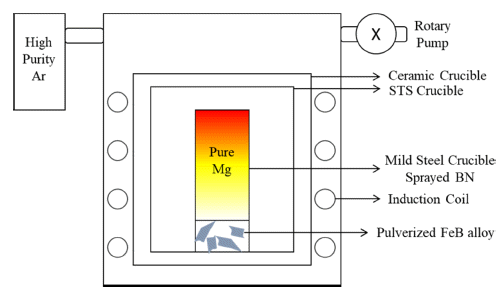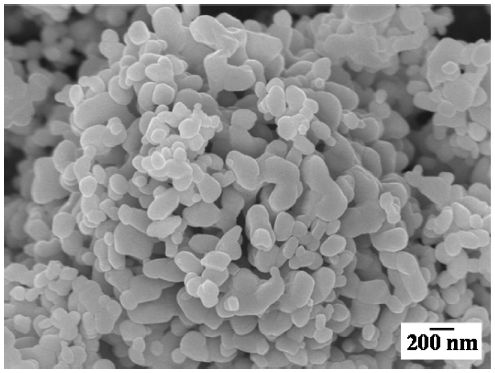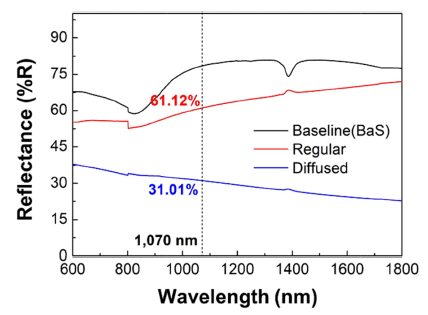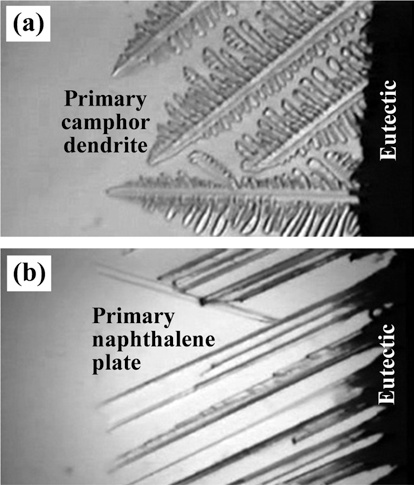Search
- Page Path
- HOME > Search
- [English]
- Study on Reaction Behavior of Mg-FeB Phase for Rare Earth Elements Recovery from End-of-life Magnet
- Sangmin Park, Dae-Kyeom Kim, Rongyu Liu, Jaeyun Jeong, Taek-Soo Kim, Myungsuk Song
- J Powder Mater. 2023;30(2):101-106. Published online April 1, 2023
- DOI: https://doi.org/10.4150/KPMI.2023.30.2.101

- 463 View
- 4 Download
-
 Abstract
Abstract
 PDF
PDF Liquid metal extraction (LME), a pyrometallurgical recycling method, is popular owing to its negligible environmental impact. LME mainly targets rare-earth permanent magnets having several rare-earth elements. Mg is used as a solvent metal for LME because of its selective and eminent reactivity with rare-earth elements in magnets. Several studies concerning the formation of Dy-Fe intermetallic compounds and their effects on LME using Mg exist. However, methods for reducing these compounds are unavailable. Fe reacts more strongly with B than with Dy; B addition can be a reducing method for Dy-Fe intermetallic compounds owing to the formation of Fe2B, which takes Fe from Dy-Fe intermetallic compounds. The FeB alloy is an adequate additive for the decomposition of Fe2B. To accomplish the former process, Mg must convey B to a permanent magnet during the decomposition of the FeB alloy. Here, the effect of Mg on the transfer of B from FeB to permanent magnet is observed through microstructural and phase analyses. Through microstructural and phase analysis, it is confirmed that FeB is converted to Fe2B upon B transfer, owing to Mg. Finally, the transfer effect of Mg is confirmed, and the possibility of reducing Dy-Fe intermetallic compounds during LME is suggested.
- [Korean]
- Research trends of MXenes as the Next-generation Two-dimensional Materials
- Hojun Lee, Yejun Yun, Jinkwang Jang, Jongmin Byun
- J Korean Powder Metall Inst. 2021;28(2):150-163. Published online April 1, 2021
- DOI: https://doi.org/10.4150/KPMI.2021.28.2.150

- 2,058 View
- 60 Download
- 3 Citations
-
 Abstract
Abstract
 PDF
PDF Interest in eco-friendly materials with high efficiencies is increasing significantly as science and technology undergo a paradigm shift toward environment-friendly and sustainable development. MXenes, a class of two-dimensional inorganic compounds, are generally defined as transition metal carbides or nitrides composed of few-atoms-thick layers with functional groups. Recently MXenes, because of their desirable electrical, thermal, and mechanical properties that emerge from conductive layered structures with tunable surface terminations, have garnered significant attention as promising candidates for energy storage applications (e.g., supercapacitors and electrode materials for Li-ion batteries), water purification, and gas sensors. In this review, we introduce MXenes and describe their properties and research trends by classifying them into two main categories: transition metal carbides and nitrides, including Ti-based MXenes, Mo-based MXenes, and Nb-based MXenes.
-
Citations
Citations to this article as recorded by- Next-generation brackish water treatment: Exploring dual-ion capacitive deionization
Yize Li, Jing He, He Liu, Chao Yan
Journal of Environmental Chemical Engineering.2025; 13(2): 116037. CrossRef - Microstructure tailoring of Nb-based MAX phase by low temperature synthesis with layer-structured Nb2C powder and molten salt method
Chaehyun Lim, Wonjune Choi, Jongmin Byun
Materials Characterization.2025; 225: 115106. CrossRef - Review on 2D MXene and graphene electrodes in capacitive deionization
Hammad Younes, Ding Lou, Md. Mahfuzur Rahman, Daniel Choi, Haiping Hong, Linda Zou
Environmental Technology & Innovation.2022; 28: 102858. CrossRef
- Next-generation brackish water treatment: Exploring dual-ion capacitive deionization
- [Korean]
- Freeze Drying Process and Pore Structure Characteristics of Porous Cu with Various Sublimable Vehicles
- Gyuhwi Lee, Sung-Tag Oh, Myung-Jin Suk, Young-Keun Jeong
- J Korean Powder Metall Inst. 2020;27(3):198-202. Published online June 1, 2020
- DOI: https://doi.org/10.4150/KPMI.2020.27.3.198

- 461 View
- 1 Download
-
 Abstract
Abstract
 PDF
PDF The effect of sublimable vehicles on the pore structure of Cu fabricated by freeze drying is investigated. The 5 vol% CuO-dispersed slurries with camphene and various camphor-naphthalene compositions are frozen in a Teflon mold at -25°C, followed by sublimation at room temperature. After hydrogen reduction at 300°C and sintering at 600 °C, the green bodies of CuO are completely converted to Cu with various pore structures. The sintered samples prepared using CuO/camphene slurries show large pores that are aligned parallel to the sublimable vehicle growth direction. In addition, a dense microstructure is observed in the bottom section of the specimen where the solidification heat was released, owing to the difference in the solidification behavior of the camphene crystals. The porous Cu shows different pore structures, such as dendritic, rod-like, and plate shaped, depending on the composition of the camphornaphthalene system. The change in pore structure is explained by the crystal growth behavior of primary camphor and eutectic and primary naphthalene.
- [Korean]
- Reflectance Characteristics of Al-Si based Alloys according to Powder Size and Composition
- Gwang Mook Choi, Hong Jun Chae
- J Korean Powder Metall Inst. 2019;26(1):22-27. Published online February 1, 2019
- DOI: https://doi.org/10.4150/KPMI.2019.26.1.22

- 465 View
- 1 Download
-
 Abstract
Abstract
 PDF
PDF In this study, the effects of powder size and composition on the reflectance of Al-Si based alloys are presented. First, the reflectance of Al-Si bulk and powder are analyzed to confirm the effect of powder size. Results show that the bulk has a higher reflectance than that of powder because the bulk has lower surface defects. In addition, the larger the particle size, the higher is the reflectance because the interparticle space decreases. Second, the effect of composition on the reflectance by the changing composition of Al-Si-Mg is confirmed. Consequently, the reflectance of the alloy decreases with the addition of Si and Mg because dendrite Si and Mg2Si are formed, and these have lower reflectance than pure Al. Finally, the reflectance of the alloy is due to the scattering of free electrons, which is closely related to electrical conductivity. Measurements of the electrical conductivity based on the composition of the Al-Si-Mg alloy confirm the same tendency as the reflectance.
- [Korean]
- Effect of Sublimable Vehicle Compositions in the Camphor-Naphthalene System on the Pore Structure of Porous Cu-Ni
- Na-Yeon Kwon, Myung-Jin Suka, Sung-Tag Oh
- J Korean Powder Metall Inst. 2015;22(5):362-366. Published online October 1, 2015
- DOI: https://doi.org/10.4150/KPMI.2015.22.5.362

- 527 View
- 1 Download
- 2 Citations
-
 Abstract
Abstract
 PDF
PDF The effect of sublimable vehicle composition in the camphor-naphthalene system on the pore structure of porous Cu-Ni alloy is investigated. The CuO-NiO mixed slurries with hypoeutectic, eutectic and hypereutectic compositions are frozen into a mold at -25°C. Pores are generated by sublimation of the vehicles at room temperature. After hydrogen reduction at 300°C and sintering at 850°C for 1 h, the green body of CuO-NiO is completely converted to porous Cu-Ni alloy with various pore structures. The sintered samples show large pores which are aligned parallel to the sublimable vehicle growth direction. The pore size and porosity decrease with increase in powder content due to the degree of powder rearrangement in slurry. In the hypoeutectic composition slurry, small pores with dendritic morphology are observed in the sintered Cu-Ni, whereas the specimen of hypereutectic composition shows pore structure of plate shape. The change of pore structure is explained by growth behavior of primary camphor and naphthalene crystals during solidification of camphor-naphthalene alloys.
-
Citations
Citations to this article as recorded by- Freeze Drying Process and Pore Structure Characteristics of Porous Cu with Various Sublimable Vehicles
Gyuhwi Lee, Sung-Tag Oh, Myung-Jin Suk, Young-Keun Jeong
Journal of Korean Powder Metallurgy Institute.2020; 27(3): 198. CrossRef - Interaction of Solid Particles with the Solidifying Front in the Liquid-Particle Mixture
Ho-Suk Lee, Kyu-Hee Lee, Sung-Tag Oh, Young Do Kim, Myung-Jin Suk
Journal of Korean Powder Metallurgy Institute.2018; 25(4): 336. CrossRef
- Freeze Drying Process and Pore Structure Characteristics of Porous Cu with Various Sublimable Vehicles
TOP
 kpmi
kpmi


 First
First Prev
Prev


